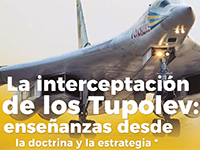La interceptación de los Tupolev: enseñanzas desde la doctrina y la estrategia
DOI:
https://doi.org/10.18667/cienciaypoderaereo.635Palabras clave:
estrategia, Tupolev, desventaja asimétrica, capacidades militaresResumen
El 1 de noviembre de 2013 dos aviones rusos tipo Tupolev, entre ellos el bombardero nuclear más rápido del mundo, ingresaron sin previa autorización sobre espacio aéreo nacional de Colombia. El proceso de interceptación y la toma de decisiones a nivel estratégico dejaron, desde la teoría de Colin S. Gray, reflexiones y enseñanzas necesarias para seguir evolucionando el proceso de toma de decisiones al interior del país y mantener la importancia de la estrategia en el uso del poder aéreo. Las enseñanzas derivadas de dicha experiencia, en particular, le permite a Colombia reflexionar sobre cómo administrar una desventaja asimétrica frente a sus adversarios. También reconocer que las decisiones militares no son las únicas determinantes de la estrategia, sino también, la voluntad política, el compromiso de una nación y la conciencia por la defensa del país.
Descargas
Referencias
Barry R. Posen (2003). Command of the Commons: The Military Foundation of US Hegemony, International Security, Vol. 28, No. 1 (Summer 2003), pp. 5-46. https://doi.org/10.1162/016228803322427965
Boyne, W. J. (2002). Air Warfare: An International Encyclopedia, Abc-clio.
Bukharin, O. (2004). Russian strategic nuclear forces, MIT Press.
Buzan, B. (1996). The timeless wisdom of realism. International theory: positivism and beyond, 47-65. https://doi.org/10.1017/CBO9780511660054.004
Buzan, B., & Hansen, L. (2009). The Evolution of International Security Studies. Political Science. https://doi.org/10.1017/CBO9780511817762
Buzan, B., Wæver, O., Wæver, O., & De Wilde, J. (1998). Security: a new framework for analysis. Lynne Rienner Publishers.
Camargo, P. P. (1984). La Convención sobre el derecho del mar: (texto y comentarios). Editorial Temis Librería.
Castro, C. A. A. and C. A. P. Herrera (2014). Reflexiones sobre la guerra de cuarta generación, una visión desde los actores sin recursos de poder en términos tradicionales. Ciencia y Poder Aéreo 9 (1): 79-87. https://doi.org/10.18667/cienciaypoderaereo.136
Chairman Mao,"The Chinese People Cannot be Cowed by the Atom Bomb," and"S.Imperialism is a Paper Tiger," in Selected Works of Mao Tse-tung, vol. 5, 152-53, 308-311
CNN. (2013). Colombia denuncia que dos bombarderos rusos violaron su espacio aéreo.
Council, N. R. D. (2006). Russian nuclear forces, 2006. Bulletin of the Atomic Scientists, 62 (2), 64-67. https://doi.org/10.1080/00963402.2006.11460975
Creveld, M. van. (1991). The transformation of war. New York: Free Press.
Douhet, G. (2009). The command of the air. University of Alabama Press.
Ehrlich, H. J., & Note, A. P. (1996). Anarchism and formal organization. Reinventing anarchy, again, 56-68.
Gladwell, M. (2013). David and Goliath: Underdogs, misfits, and the art of battling giants. Hachette UK.
Gray, C. S. (2012). The Airpower Advantage in Future Warfare: The Need for Strategy, Lulu. com.
Gray, C. S. (2015). Strategic Studies and Public Policy: The American Experience. University Press of Kentucky.
Hollis, M. (1990). Explaining and understanding international relations.
Holsti, K. J., & Holsti, K. J. (1996). The state, war, and the state of war (No. 51). Cambridge University Press. https://doi.org/10.1017/CBO9780511628306
Jeremi S. (2003). Power and Protest: Global Revolution and the Rise of Détente. Cambridge, Massachusetts: Harvard University Press, pp. 1-87
Jervis, R. (1986). Cognition and political behavior. Political cognition, 319-336.
Kennan, G. F. (1947). Memoirs, 1925-1950. Boston, 1967. For the Press. May, 7, 1.
Kenneth, W. (1959). Man, the State and War. A theoretical analysis. New York: Columbia University Press.
Lieber, K. A., & Press, D. G. (2006). The end of MAD? The nuclear dimension of US primacy. International Security, 30(4), 7-44. https://doi.org/10.1162/isec.2006.30.4.7
Lüthi, L. (2008). The Vietnam War and China's Third-Line Defense Planning before the Cultural Revolution, 1964-1966. Journal of Cold War Studies, 10(1), 26-51. https://doi.org/10.1162/jcws.2008.10.1.26
Morgenthau, H. (1948). 1978. Politics among nations: The struggle for power and peace. New York: Alfred S. Knopf.
Nye Jr, J. S., & Lynn-Jones, S. M. (1988). International security studies: a report of a conference on the state of the field. International Security, 12(4), 5-27. https://doi.org/10.2307/2538992
Riquelme-Cortado, R. M. (1985). Reflexiones sobre la firma y la ratificación de la Convención de las Naciones Unidas sobre el Derecho del Mar (1982). A propósito de la firma por España.
Shang, C. (2011). Dancing with his "Lesser Evil"-Mao's China from 1962-68 and the road to rapprochement with the United States. University of Arkansas.
Skinner, Q. (1978). The Foundations of Modern Political Thought. The Age of Reformation (Vol. 2). Cambridge University Press.
Smoke, R. (1975). National Security Affairs. Hand- book of Political Science, 8, 247-362.
Terriff, T., Croft, S., James, L., & Morgan, P. (2000). Security studies today. Polity.
Trest, W. A. (1998). Air Force Roles and Missions: A History. Government Printing Office. https://doi.org/10.21236/ADA476260
Tse-Tung, M. (2014). Selected works of Mao Tse-tung (Vol. 5). Elsevier.
Waltz, K. N. (1988). The origins of war in neorealist theory. The Journal of Interdisciplinary History 18(4): 615-628. https://doi.org/10.2307/204817
Waltz, K. (1979). Theory of international politics: reading. University of California, Berkeley: Addison-Wesley Publishing Company, In.
Wohlforth, W. C. (1993). The elusive balance: power and perceptions during the Cold War. Cornell University Press.
Wolfers, A. (1952). "National security" as an ambiguous symbol. Political Science Quarterly, 67(4), 481-502 https://doi.org/10.2307/2145138

Publicado
Número
Sección
Licencia
Derechos de autor 2021 Escuela de Postgrados de la Fuerza Aérea Colombiana

Esta obra está bajo una licencia internacional Creative Commons Atribución 4.0.
Declaración de cesión de los derechos de autor a la revista
Los autores ceden la Revista los derechos de explotación (reproducción, distribución, comunicación pública y transformación) para explotar y comercializar la obra, entera o en parte, en todos los formatos y modalidades de explotación presentes o futuros, en todos los idiomas, por todo el periodo de vida de la obra y por todo el mundo.
Todos los contenidos publicados en la revista científica Ciencia y Poder Aéreo están sujetos a la licencia reconocimiento 4.0 Internacional de Creative Commons, cuyo texto completo se puede consultar en http://creativecommons.org/licenses/by/4.0/
La licencia permite a cualquier usuario descargar, imprimir, extraer, archivar, distribuir y comunicar públicamente este artículo, siempre y cuando el crédito se dé a los autores de la obra: a los autores del texto y a Ciencia y Poder Aéreo, Revista Científica de la Escuela de Postgrados de la Fuerza Aérea Colombiana. Excepto cuando se indique lo contrario, el contenido en este sitio es licenciado bajo una licencia Creative Commons Atribución 4.0 internacional.
Para usos de los contenidos no previstos en estas normas de publicación es necesario contactar directamente con el director o editor de la revista a través del correo cienciaypoderaereo@epfac.edu.
La Escuela de Postgrados de la Fuerza Aérea Colombiana y esta publicación no son responsables de los conceptos emitidos en los artículos, ni de los metadatos aportados ni de las filiaciones que los autores declaren, ya que esta es responsabilidad plena de los autores.





















